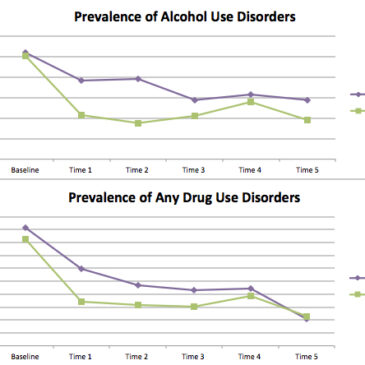The United States has the largest prison population in the world. About 1.4 million adolescents, disproportionately black and Latino, are arrested every year, resulting in over 250,000 detentions. Previous research has documented high rates of alcohol and substance use disorders among youth in the juvenile justice system, but there are few longitudinal studies following these adolescents into young adulthood. Therefore, what we know about the persistence of these disorders is limited. Dr. Leah Welty and her colleagues used 12 years of longitudinal data from youth in detention centers in Chicago, IL to fill that gap.
What was the research question?
How persistent are substance use disorder experiences among incarcerated adolescents over time?
What did the researchers do?
Welty and her colleagues conducted a baseline survey with a random sample of adolescents during intake to the Cook County Juvenile Temporary Detention Center in Chicago, IL between 1995-1998 (median age = 15). They conducted follow up interviews with the full sample (n = 1829; 1172 males, 657 females) 3, 4.5, 6, 8, and 12 years after intake, whether they lived inside or outside of a correctional facility. To measure substance use disorders during the past 6 months at baseline, researchers used the Diagnostic Interview Schedule for Children. The researchers used the Diagnostic Interview Schedule, IV to measure lifetime and past year substance use disorders during following up interviews.
What did they find?
At 12 years following correctional center intake (median age = 28), 91.3% of male and 78.5 % of female participants reported a substance use disorder at some point during their lifetime. Lifetime alcohol and marijuana use disorders were most common. The prevalence of past year substance use disorders decreased over the 12 years, from about 50% at baseline to about 20% at year 12 (see Figure 1). Throughout the study period, non-Latino white participants were more likely to report an alcohol or drug use disorder than Latino or African-American participants.
Why do these findings matter?
Across all race, ethnicity, and gender groups, the prevalence of lifetime SUD for participants 12 years following detention center intake was substantially higher than the similarly aged, general US population (ages 25-30). We need to expand access to evidence-based substance use prevention and treatment services, both during correctional stays and after release. Additionally, we need to learn more about how different factors of incarceration (i.e., reason for incarceration, number or length of incarcerations, facility type, and more) affect substance use disorders over time.

Figure. Prevalence of alcohol and drug use disorders between intake and time 5 (12 years later) among incarcerated adolescents. Click image to enlarge.
Every study has limitations. What were the limitations in this study?
The sample was limited to a single jurisdiction. Therefore, these results might not be generalizable to other detained youth populations across the country. Additionally, no data were collected on comorbid psychiatric disorders, but past research has also found elevated rates of psychiatric disorders in incarcerated youth populations in the USA and Canada.
For more information:
Find the original publication abstract here.
For similar publications and treatment resources for incarcerated or formerly incarcerated adolescents, please visit SAMHSA’s website.
If you or a loved one has a problem with substance use, please visit our addiction resources here.
— Layne Keating
What do you think? Please use the comment link below to provide feedback on this article.




